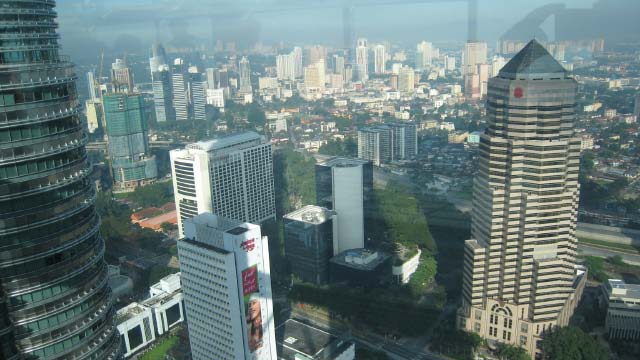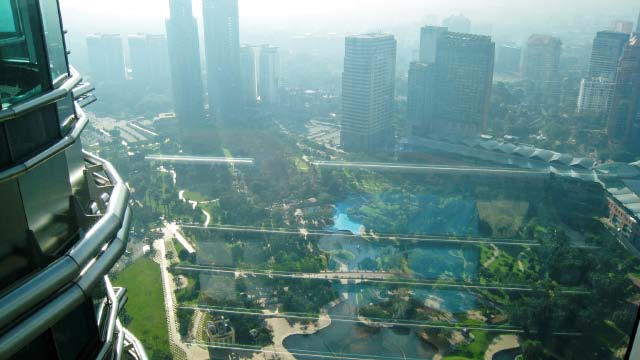|
|
|
PORT DICKSON, MELAKA & KUALA LUMPUR - MALAYSIA |
|
From Singapore we headed up the Malacca Strait stopping briefly at Pulau Pisang, 65 miles from Singapore, then continued to Pulau (meaning "Island") Besar the following day. |
Pulau Besar, Water Islands. November 11, 2006
We anchored at a beautiful quiet spot in front of a tiny beach. Tony from Tactical Directions had us all over to his boat to celebrate our 16 Anniversary (Sept 10). We had a great potluck party Leaving the anchorage from Pulau Besar, we rounded the island, surprised to see an impressive skyline of high rises and large buildings of Melaka. It was so incongruous to the serene bay we had just emerged from. |
The Malacca Straits were a challenge to endure, with floating debris and garbage, long fish nets everywhere, logs, muddy waters and numerous fish boats, ships and cruise liners everywhere. But the hype about piracy was really not an issue. We did not hear of any incidents and we did not experience any unusual activity. In fact, there was a notable presence of military ships throughout the Straits and we could hear them contacting merchant vessels to confirm their credentials. There is NO wind in Malaysia! We motored everywhere, often against current. We used an enormous amount of diesel during our passages but at least the waters were usually relatively flat. The only absolute was the predictable violent afternoon thunderstorms packed with hazardous lightening accompanied by torrential rains. We got in the habit of putting our electronics in the oven each afternoon in preparation for the onslaught. Malaysia was a surprise to us. We did not expect it to be so developed and modern. There is a wide mix of cultures here but we did not find the people nearly as friendly as in Indonesia. |
PORT DICKSON Admiral Marina Nov 12-14, 2006 We arrived at Port Dickson Admiral Marina one day after all the scheduled activities for the Rally participants so as we were pulling into the marina, most of the boats were vacating to move north and we waved hello-goodbye in passing. We were pleased to find the marina very upscale and modern. The slips were new, the dock clean and the resort included a swimming pool, always a bonus! |
||
We spent the next days getting settled, cleaning the boats and making a quick trip to town by taxi. Port Dickson is a small centre, with rather conventional streets and storefronts, but we found an ATM, a phone card centre, a grocery store and a restaurant for lunch. We were reminded of the cleanliness of Singapore compared to its neighbors, Indonesia and Malaysia. It was difficult to adjust to the smell of garbage in the sewers alongside the streets and wondered about eating at the restaurants beside the road. It was very hot and humid, almost impossible to sleep at night even with our little table fan plugged into the dock and situated inches from my face in bed. |
|
MELAKA (Melacca) Nov 15-16, 2006
Our group took 2 taxis to Melaka where we planned to stay overnight and explore the fascinating old trading port. We left the Marina early and so our rumbling tummies prompted a stop at a roadside cafe for breakfast. Gord thought he would keep it simple and order an omelet. He always says that it's hard to screw up an egg! Well it turned out that they had no idea what an omelet was and something was lost in translation between us, our driver and the cook, because out of the kitchen came a single boiled egg on a plate. However when Gord cracked it the running innards quickly squirted out....it was just barely warmed! So he tried again, explaining that the egg needed to be cooked without the shell. He eventually settled for a version of fried egg! The driver ate the original boiled egg and seemed to really enjoy it! |
|
|
|||
|
Upon arriving in Melaka an hour later, we drove down narrow streets into the oldest section of town where we checked into the Baba Hotel. The Baba Hotel was the location where "Entrapment" was filmed and it was interesting to recognize many of the sets that were used in the movie. |
|||
Old Town Melaka The buildings surrounding the hotel were hundreds of years old and we did not see any indication of the highrise shoreline that we spotted coming from Water Islands. Melaka is known for its history, museums (which are surprisingly numerous!), and the unique Baba-Nyonya community, descendants of the original Chinese settlers who married Malays. The old town reflects the Portuguese, British and Dutch era in its architecture. Hundreds of small shops and eateries line the narrow streets with no sidewalks. Shophouses were interspersed with temples, shrines and mosques, each with amazingly intricate decor of carved stone, inlaid gold, elaborately engraved pillars and fine craftsmanship. |
|
We spent the first day shopping and exploring the city, wandering up and down the quaint cracked streets, each with its own cultural personality and charm. |
| The windmill in Dutch Square with beautiful gardens as seen from the windows of the Art Gallery. Overlooking the main square is Melaka's Christ Church landmark. | |||
| Jonkers Street (China Town) is best known for shopping treasures. A group of Muslin girls wanted to take OUR photo |
Trishaws decorated with flowers will take you anywhere |
||
We visited the Maritime Museum, housed in a replica of the Portuguese galleon which sank off Melaka.
|
Later we met for lunch for scrumptious Malay food. |
||
Kongsi (Clan Temples) As we walked down the sidestreets, clouds of incense billowed out of an abundance of striking Chinese clan temples, each with an extravagant array of carved colorful mythical figures made from porcelain and glass reflecting Anglo-Indian design. Red and Gold were always the primary colors, accented by elaborately engraved showcases of lacquer work in the form of porticoes and pillars. . |
We had met an ex-pat from New Zealand who, along with his Malaysian wife, operated a Jazz Bar in Melaka. He offered to open the bar up for us at 10:30 that evening so after dinner we joined a few locals and had a fun night of partying and dancing. |
|||
We found many street bars and frequented a number of them after supper. |
Our new friend jumped from piano to keyboard to guitar and accompanied his wife singing. Becky and I were recruited for backup. |
||
|
Because Annie would not partake in the backup chorus, she was subjected to a test of suitors. First, Liam does his best to win her heart |
Gord thinks a dance will do the trick But Tony gets a ribbon for going on his knees! |
|
A walk along the river that runs through Melaka |
ramshackle housing along the river banks |
||
|
Melaka Tree |
Business is slow! |
|
We all visited the Cheng Ho Cultural Museum (1421 Museum) and our guided tour revealed much history and culture of Melaka 600 years ago. The museum occupies the original government depot built by Admiral Cheng Ho, the Ming Grand Eunuch. His fleet of several hundred ships visited 33 countries in the Pacific and Indian Ocean over half a century before Columbus discovered America. Included in the interactive exhibits was a puppet show. Once again, Gord and I took the opportunity to pray for safe passages and fair winds. From the top of the museum there was a great view of Melaka, old and new intermingled. |
||||
Trishaws for Transport Everywhere were colorfully decorated trishaws, overloaded with flowers, ornaments and lights. Most had a bank of batteries that supplied the power for the lights, sirens, horns and music. We organized 2 trishaw to tour around the city. Ours was pedaled by an 80 year old man, with sticks for arms and toothpicks for legs. He had been operating his rickshaw for over 30 years. At 18, he worked his trishaw during the Japanese occupation of Melaka! |
|
|
There were several spots, although flat, where his struggle to keep the bike moving was proving fruitless, so Gord got off and pushed! |
|
|
We slowly traversed the streets of downtown Melaka and ended up in the oldest part of the city where we stopped at the Hang Li Ph Well which was once the main source of water for the town. |
 |
After a full day of sightseeing we
were ready to return to Port Dickson so arranged a taxi back to
the boats. |
|
The highlight of KL is the Night Markets of Chinatown. AT 5 pm, the main street is transformed and a huge array of shoes, purses, sunglasses, T-shirts, jewelry and of course, the Rolex knockoffs, appear from nowhere as the hawkers set up their temporary stalls, crammed together along narrow aisles packed with people looking for a deal. But you have to haggle hard. These guys are pros, and tough. But I did manage to get some good deals and it was really fun. |
 |
 |
 |
|
| Its architecture is representative of the country's dominant cultures - the Malay, Chinese and Indian. | |||
KL Radio Tower Next stop, a visit to the KL Radio Tower, one of the highest free standing structures in the world. This sighting involved an entrance fee but it included a personal MP4 description of all the buildings, which encompassed 360 degrees so we got a great overview of the city from that perspective. |
|
For a change of scenery, we took the train back to Port Dickson, which proved to be a mistake. The scenery was not much more impressive, the seats were hard, the cars packed, and the commuter made stops every 2 minutes all the way to the end of the line so the trip was long and uncomfortable (and more expensive than the express bus). The sky opened up just as we returned to the boats, with the usual display of vivid lightning and a heavy downpour. Nov. 20 We left Port Dickson deciding to bypass Port Klang and the Selangor Yacht Club because we heard that the water was polluted and shallow. Instead, we made way for Pulau Pankor. |